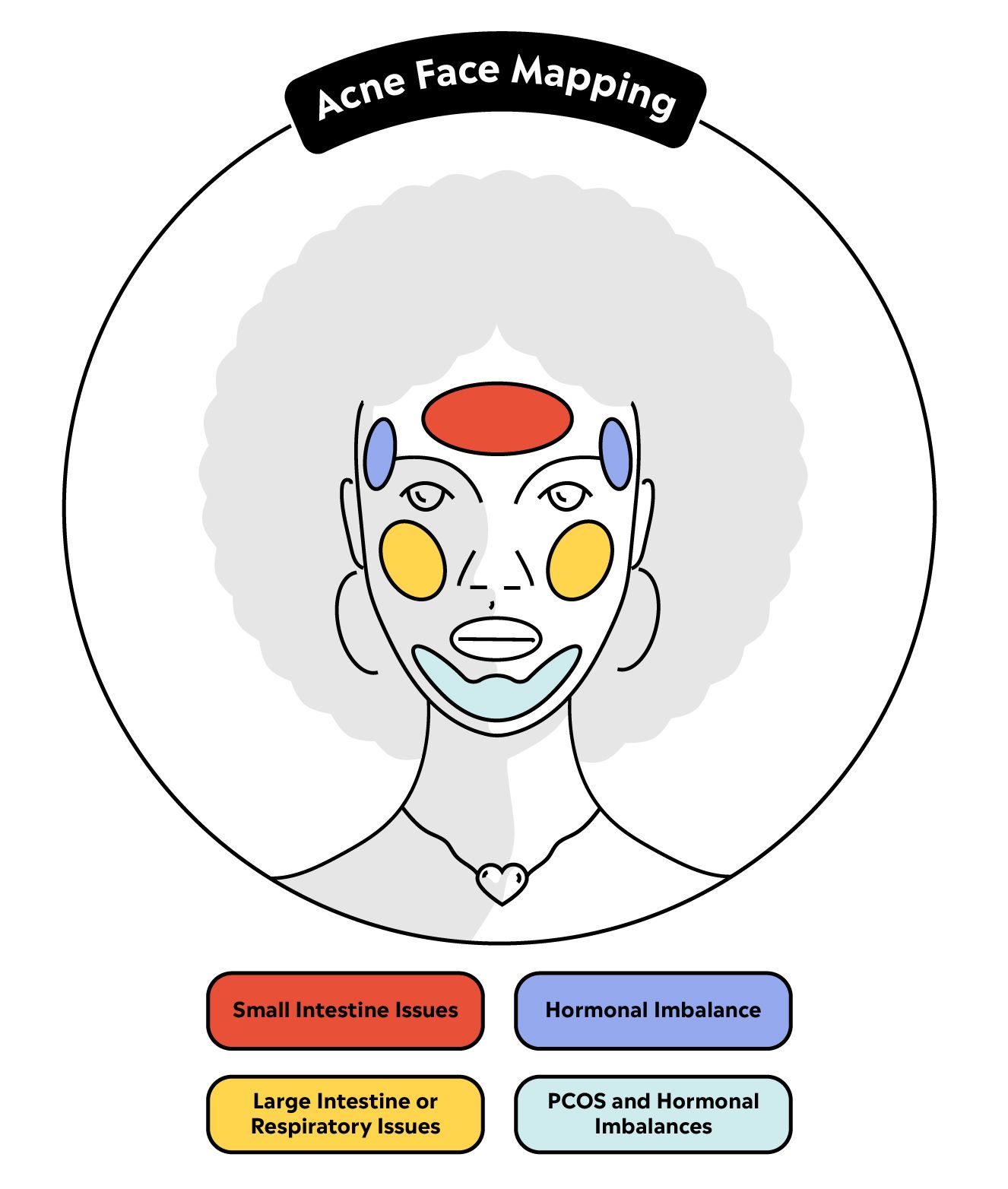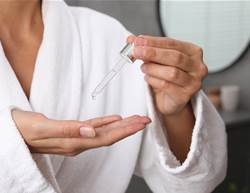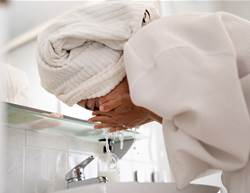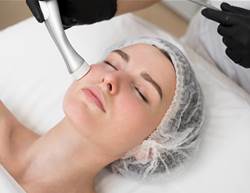Ever wonder why blackheads tend to form on your nose and your chin breaks out with cystic bumps every month? The ancient technique of face mapping could help explain why.
Long before there were X-rays, MRIs and other modern ways of “seeing” inside the body, face mapping was used in Traditional Chinese Medicine (TCM) and Ayurveda to assess the health of internal organs from the outside.
What is face mapping?
Areas of the face, like the cheeks, forehead and chin, are believed to correspond to organs in the body, explains dermatologist Dr Rachel Nazarian. “The idea is that the skin could be used to map out sources below the surface that require medical attention," she says. "For example, if you had blemishes on your forehead, perhaps a problem with the small intestine was to blame."
While Western medicine doesn’t incorporate face mapping, Dr Nazarian says your complexion can offer clues about what's going on inside your body. Breakouts on the chin and jawline are often linked to polycystic ovarian syndrome (PCOS), Dr Nazarian says.

And some research suggests that rosacea and bumps around the eyes, nose, and chin may be related to internal colon bacteria. The theory is that when you eat a poor diet, your gut leaks toxins that release inflammation throughout the body. "Your skin is an organ that responds to internal controls and direction," Dr. Nazarian explains.
Although acne on a specific spot on your face doesn't always necessarily give intel into how your insides are functioning, Dr Nazarian says, "it's important to acknowledge these often-subtle changes to identify deeper issues that may be jeopardizing your health."
What does your skin say about your health?
The best way to use the information you get from face mapping is to ensure you're following good skin hygiene practices and eating a healthy diet packed with antioxidant-rich foods. By nourishing your body with nutrient-dense foods, inflammation in your body is less likely to manifest into zits.
T-Zone
Face mapping suggests: The forehead is linked to the small intestine. Poor kidney function can be mapped to puffiness around the eyes.
What derms say: The T-zone, which consists of your forehead, nose, and chin, is an area of high oil production. Acne that forms in this area is often due to sweat gland occlusion, says dermatologist Melissa Kanchanapoomi Levin. Women who live in humid environments or wear a lot of hats and headbands are especially susceptible to breakouts on the forehead. Heavy makeup can be a culprit, too, so Dr Kanchanapoomi Levin suggests looking for cosmetics labeled non-comedogenic that won’t clog pores.
“The type of acne is more important than the area,” notes Dr Nazarian, who says the nose and forehead tend to have small blackheads and whiteheads. “Medication containing retinoids are the ideal type of medication to treat this.”
Topical retinoids, which are all vitamin A derivatives, are considered the first line treatment for mild, moderate, and severe acne, explains Dr Kanchanapoomi Levin.
Chin, jawline
Face mapping suggests: Acne in this area may be related to hormones and endocrine function.
What derms say: Those painful pimples on your chin and along your jawline might be the result of a hormonal imbalance. “Certain hormones can overstimulate oil glands, clog pores, and cause painful cystic pimples,” says Dr Kanchanapoomi Levin.
Her go-to treatment for this type of adult acne is spironolactone, a diuretic and androgen blocker. It’s often prescribed to women in conjunction with oral birth control pills to help clear cystic acne.
“Spironolactone was originally formulated to treat hypertension but at lower doses, it’s used for hormonal acne because it blocks androgens (testosterone), which are the reason for masculine traits such as increased oil and sebum production, excess hair growth, and patterned hair loss,” she says.
Dermatologist Dr Adarsh Vijay Mudgil also uses spironolactone for his female patients with hormonal acne on the lower part of the face. “This is sort of a Western take on face mapping,” he says. Dr Nazarian recommends using acne treatments with ingredients such as salicylic acid or benzoyl peroxide.
Edge of face
Face mapping suggests: Pimples at the edges of your face may be related to a hormonal imbalance.
What derms say: Although acne here can also be hormonally related, evaluate the products you use if it recurs, says Dr Kanchanapoomi Levin. “If your acne is predominantly along the hairline, forehead, behind the ears, or outside parts of the cheeks, it's important to look at your hair products that contain oil and chemicals that can clog and irritate the skin.”
Dr Nazarian says products with salicylic acid can be helpful for exfoliating and de-clogging pores. She also suggests using cleansers and creams with benzoyl peroxide, which is great as an antibacterial agent.
Cheeks
Face mapping suggests: Breakouts in the cheeks may be related to large intestine or respiratory issues.
What derms say: If breakouts cluster on your nose and cheeks and you have sensitive skin or have redness, it may be rosacea, a condition that mimics acne with small red bumps, says Dr Nazarian. But dietary and lifestyle chances can help improve breakouts in this area. “I recommend topical and oral anti-inflammatories and probiotics in the diet,” she says.
Dr Kanchanapoomi Levin says sharing information about your diet with your dermatologist can help guide treatment. “Foods that are high on the glycemic index or those with high natural hormone levels, such as non-organic dairy, can increase inflammation that has been theorized to worsen acne.”
Your phone may also be a culprit for the breakouts on your cheeks. “Your cell phone’s surface can be full of oil and bacteria that transfers to and from your face,” says dermatologist Dr Tsippora Shainhouse. “Wipe down your screen a few times a day and be aware of where you leave your phone.”
The bottom line: Regardless of the location of breakouts, it’s always important to have an evaluation with your dermatologist whenever you have concerns, says Dr Nazarian. “The skin is an organ that often does reflect problems happening inside the body, and your dermatologist will know when to investigate further.”










